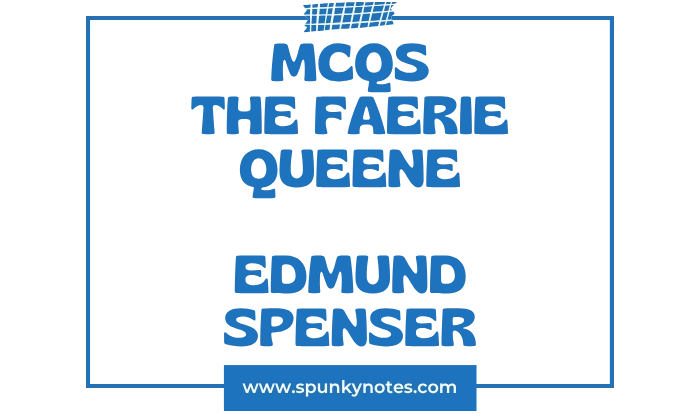

Estimated Reading Time: 17 min
The Faerie Queene MCQs
1. What does the narrator state will “moralize” his song?
A. Gentle deeds
B. Fierce warres and faithfull loues
C. Shepherd’s weeds
D. Gloriana’s grace
2. What is the narrator changing from “Oaten reeds” to “trumpets sterne” to sing of knights and ladies?
A. His old songs
B. His peaceful trade
C. His former Muse
D. His subject matter
3. Whose “faire beames” does the narrator ask for help from to shed light on his “feeble eyne”?
A. His mother
B. Phoebus
C. Holy Virgin chiefe of nine
D. Greatest Gloriana
4. What image is prominently featured on the shield of the Redcrosse Knight?
A. A golden eagle
B. A roaring lion
C. A silver crown
D. A bloody Crosse
5. Who bestowed the great adventure upon the Redcrosse Knight?
A. Phoebe
B. Charissa
C. Gloriana
D. Duessa
6. The Redcrosse Knight and his Lady were constrained to seek shelter due to:
A. Foul Error
B. A hideous storme of raine
C. A false hermit
D. A Sarazin attack
7. Where does the Redcrosse Knight first encounter his monstrous foe, Error?
A. The Faerie Lond
B. The wandring wood
C. The house of Pride
D. Morpheus house
8. What did the monster Error vomit forth?
A. Frogs, toads, and ink
B. Blood and paper
C. Bookes and papers
D. Serpents and worms
9. Who is the “man, whose Muse whilome did maske, / As time her taught, in lowly Shepheards weeds”?
A. The Redcrosse Knight
B. The author of the poem
C. Archimago
D. Prince Arthur
10. What caused the ramping Lion to cease his attack and follow Una?
A. Una used a spell
B. The Dwarf tamed him
C. His bloudie rage asswaged with remorse
D. Una’s great courage
11. What is Archimago’s main function early in the poem (Cantos I-II)?
A. To offer counsel
B. To inspire faithful love
C. To create illusions/deceit
D. To guide the knight
12. After the Redcrosse Knight abandons Una, Archimago disguises himself as whom to follow Una?
A. Sans Loy
B. A young Squire
C. That good knight
D. A Pilgrim
13. The letters on the shield of the first Sarazin Redcrosse kills, Sans foy, mean:
A. Without wealth
B. Without joy
C. Without truth
D. Without faith
14. What sad fate befell the knight Fradubio?
A. He was banished by Duessa
B. He was turned into a tree
C. He was slain by Sans Foy
D. He became a ghost
15. Who rescued Sans Joy from Redcrosse after the duel in the House of Pride?
A. Duessa
B. Gloriana
C. Infernal powres
D. Night
16. Night reveals Duessa is the daughter of:
A. Pride and Tyranny
B. Deceipt and Shame
C. Error and Sin
D. Greed and Lust
17. What caused the giant Orgoglio to become instantly blind and weak when facing Prince Arthur?
A. Talus’s flail
B. Arthur’s spear
C. RCK’s shield
D. Arthur’s shield
18. What happens to Orgoglio’s huge great body after he is struck?
A. It turns to stone
B. It vanishes like an emptie bladder
C. It explodes violently
D. The Dwarf devours it
19. Name the three daughters of Coelia (Holiness) who instruct the Redcrosse Knight.
A. Truth, Grace, Patience
B. Temperance, Faith, Hope
C. Fidelia, Speranza, Charissa
D. Modesty, Obedience, Love
20. Whom does the Redcrosse Knight eventually fight to free Una’s parents?
A. Sans Loy
B. The huge great Dragon
C. Orgoglio
D. Archimago
21. The Legend of Sir Guyon is primarily focused on which virtue?
A. Justice
B. Temperance
C. Chastity
D. Courtesy
22. Who guides Sir Guyon on his quest, advising him to exercise reason?
A. An aged Squire
B. A Palmer
C. Gloriana’s messenger
D. The Dwarf
23. What specific name is given to the babe found beside the slain knight whose hands are covered in blood?
A. Amidas
B. Guyon
C. Ruddymane
D. Cymochles
24. When Guyon tries to wash the babe’s bloody hands in the well, what happens?
A. The blood vanishes immediately
B. The hands remain bloody
C. The water turns muddy
D. The water turns pure snow
25. Furor, the cruel wight Guyon battles, is the son of whom?
A. Braggadocchio
B. Occasion
C. Cymochles
D. Acrasia
26. What beautiful woman does Mammon offer Guyon as a spouse?
A. Duessa
B. Lucifera
C. Philotime
D. Fidessa
27. Who is the sturdy villein that guards the entrance to Mammon’s great golden room?
A. Furor
B. Mammon himself
C. A guard of golden mould
D. Archimago
28. The hundred furnaces in Mammon’s domain are tended by:
A. Giants
B. Fairies
C. Feends
D. Cursed men
29. Prince Arthur learned his lineage and virtue from an old man named:
A. Merlin
B. Timon
C. Archimago
D. Talus
30. Arthur’s shield was crafted by whom?
A. Talus
B. Merlin
C. Timon
D. The Faerie Queene
31. Who were the two fierce brethren that assaulted Guyon after his encounter with Mammon?
A. Braggadocchio and Trompart
B. Pyrrochles and Cymochles
C. Furor and Occasion
D. Sansjoy and Sansloy
32. The knight who overthrew Marinell was a single damzell bearing what notable item?
A. A magical sword
B. An enchaunted lance
C. A massive club
D. A silver shield
33. Britomart wounded Marinell on what geographical feature?
A. A sandy shallow
B. A rocky hill
C. The Rich strond
D. The wandering wood
34. Britomart first saw the man she loved (Artegall) how?
A. In a tournament
B. In a magic mirror
C. In a waking dream
D. In a prophetic vision
35. Britomart sought out Merlin for what primary reason?
A. To seek his kingdom
B. To be armed with a shield
C. To find her hidden love
D. To learn magic spells
36. Who is Florimell’s true love?
A. Satyrane
B. Marinell
C. Artegall
D. Braggadocchio
37. Ate, riding with Blandamour and Paridell, is the mother of:
A. Debate and dissention
B. Lust and gluttony
C. Greed and pride
D. Tyranny and wrong
38. Agape, mother of the three brothers, sought to lengthen her sons’ lives by:
A. Giving them a magic sword
B. Knitting their souls into one
C. Infusing their lives into the next brother
D. Making them invulnerable
39. Cambina stops the bloody battle between Cambell and Triamond by using:
A. Her bare hands
B. Her powrefull wand
C. Her magic mirror
D. Arthur’s shield
40. What virtue did Florimell’s Girdle retain for the wearer?
A. It guaranteed long life
B. It granted victory in battle
C. It bound lascivious desire
D. It made the wearer invisible
41. What happens to the False Florimell when Britomart confronts Braggadocchio and uses the True Girdle?
A. She melts away
B. She runs away swiftly
C. She is turned back into wax
D. She is proven chaste
42. What weapon does Artegall’s iron groom, Talus, carry?
A. An yron sword
B. A golden club
C. An yron flale
D. A brazen shield
43. Pollente defeats his foes on the narrow bridge chiefly by what method?
A. He uses a magic dart
B. He knocks them into a deep river
C. He employs traps and guile
D. He challenges them to swim
44. Munera, daughter of Pollente, is described as having hands and feet made of what?
A. Iron and copper
B. Silver and gold
C. Brass and steel
D. Pearl and diamond
45. When Artegall challenged the Giant, what happened when the Giant tried to weigh the words “true or false” and “right or wrong”?
A. The words crushed the scale
B. The words flew out of the ballaunce
C. The scale balanced perfectly
D. The scale weighed heavily
46. Who defeats Sir Artegall by taking advantage of his momentary pity for her beauty, capturing him?
A. Duessa
B. Radigund
C. Munera
D. Irena
47. Who slays the Amazon Radigund, thereby freeing Sir Artegall?
A. Prince Arthur
B. Britomart
C. Talus
D. Clarinda
48. Queen Mercilla is best known for what ruling quality?
A. Justice only
B. Bounty and grace
C. Wrath and power
D. Chastity
49. The Legend of Sir Calidore is focused on which virtue?
A. Friendship
B. Temperance
C. Holiness
D. Courtesie
50. Sir Calidore chose to abandon his quest to remain with the rusticke sort, specifically because of his love for whom?
A. Serena
B. Mirabella
C. Pastorella
D. Irena
Brief Overview
The Faerie Queene is a long, unfinished epic poem by Edmund Spenser. It was first published in two parts, in 1590 and 1596. It is an allegory, meaning the characters and events stand for deeper religious and moral meanings.
The poem is dedicated to Queen Elizabeth I, who is represented by the poem’s title character, the Faerie Queene, Gloriana. Spenser intended the poem to have twelve books, each focusing on a different moral virtue, but he completed only six.
The central plot follows Gloriana’s annual twelve-day feast. She sends out twelve different knights on quests. Each knight represents a specific Christian virtue, and their adventures test and strengthen that quality. For example, the first book features the Redcrosse Knight, who represents the virtue of Holiness.
The narrative combines elements of Arthurian romance, classical mythology, and Christian theology. The poem’s primary goal is stated in the prologue: “to fashion a gentleman or noble person in virtuous and gentle discipline.”
The poem is written in a distinct, complicated form now called the Spenserian stanza. This stanza has nine lines and a unique rhyme scheme. The Faerie Queene is famous for its lush, imaginative descriptions and its complex mix of morality, history, and fantasy.


